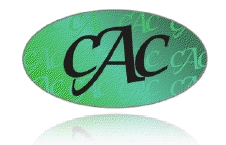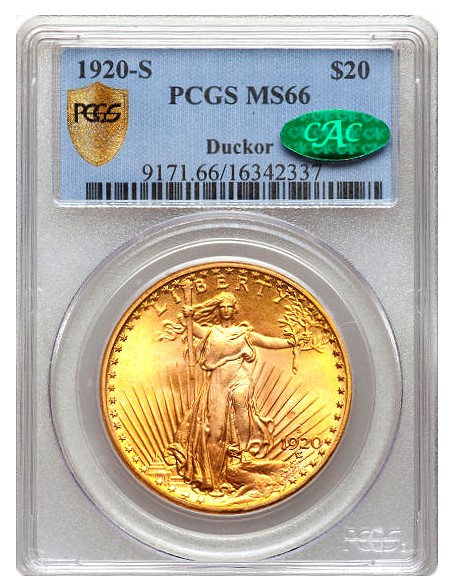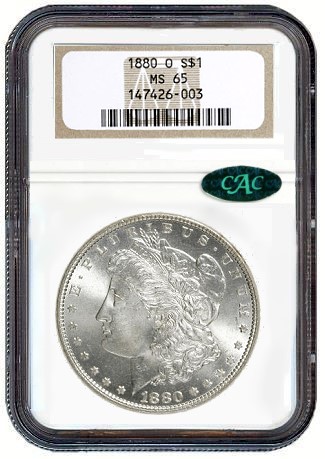By Mark Ferguson for CoinWeek – MFRareCoins.com ……
Market Study Background
It’s common knowledge that CAC verified coins have been selling for premium prices since the inception of CAC on November 1, 2007. But until now, collectors, investors and dealers haven’t had a resource to find out how much those price premiums amount to by series and grade for PCGS and NGC graded coins that have the CAC “green bean” sticker of approval versus those without CAC stickers.
 I’ve just concluded a comprehensive market study that does just that. It reveals the amounts of price premiums CAC verified coins are selling for, by series and grade, as compared to non-stickered PCGS and NGC coins.
I’ve just concluded a comprehensive market study that does just that. It reveals the amounts of price premiums CAC verified coins are selling for, by series and grade, as compared to non-stickered PCGS and NGC coins.
The concept for this exhaustive market study , which analyzes recent auction sales of more than 5,500 type coins – from one cent coins through $20 gold coins, originated with the author and CoinWeek. The study was performed independently of CAC, but was commissioned by and conducted in cooperation with CoinWeek and CAC – Certified Acceptance Corporation respectively.
This analysis is not a random sample. It’s a complete market study that compares auction sales prices of like-kind CAC-stickered coins versus non-stickered NGC and PCGS graded coins. Major coin auctions between January 1, 2010 and June 30, 2012 have been thoroughly examined by series and grade. For very common coins, like Morgan and Peace Dollars, Walking Liberty Half Dollars, and $20 Saint-Gaudens gold coins, where there was enough data to analyze, auction prices realized were reviewed for a more recent timeline – between January 1, 2011 and June 30, 2012.
Importantly, auction price trends indicate that the coin market, for the coins and grades analyzed in this market study, has generally been steady and stable since the beginning of 2010 for the types and grades of coins studied. It’s the market segment for scarcer and rarer issues for which prices have been appreciating during that time. After the financial meltdown of 2008, most coin buyers took a cautious wait-and-see attitude during the following year, 2009, finally starting to open their wallets during the fall and winter of that year. Therefore, coins sold during 2009 were not included in this market study.
 This study focuses on common high grade, Mint State “Type Coins” – those issues which are the most common coin issues of a specific design type in a particular denomination. Proof strike issues were not included in this market study. Additionally, sales of coins from series with an element of scarcity are too difficult to track in quantity, for obvious reasons, so there are many series that could not be examined. Examples of such coins are “early” coins, like Flowing Hair and Bust material, and early gold coinage – all minted prior to about the 1840 time period. Additionally, CAC does not review or sticker “modern” coinage, with the recent exception of Eisenhower Dollars; so modern coinage is also not a part of this market study.
This study focuses on common high grade, Mint State “Type Coins” – those issues which are the most common coin issues of a specific design type in a particular denomination. Proof strike issues were not included in this market study. Additionally, sales of coins from series with an element of scarcity are too difficult to track in quantity, for obvious reasons, so there are many series that could not be examined. Examples of such coins are “early” coins, like Flowing Hair and Bust material, and early gold coinage – all minted prior to about the 1840 time period. Additionally, CAC does not review or sticker “modern” coinage, with the recent exception of Eisenhower Dollars; so modern coinage is also not a part of this market study.
Because of the amount of historical sales data available, and the capability of its search functions, Heritage Auctions was used as the source for all of the data analyzed. However, major auctions conducted by other companies were considered and looked at, but at this time, no other auction company provides such a comprehensive range of coins sold for which the sales data is so easily accessible by computer searches on the company’s web site – an important consideration for this market study.
I also want to repeat…this market study is not a random sample. It analyzes all sales of the coin issues and grades studied during the time periods reviewed. In other words, all sales of CAC-stickered examples and all sales of NGC and PCGS non-stickered examples of like-kind coins were tallied and analyzed for each coin type and grade examined in this market study. The full CAC market study report provides detailed lists of the specific dates and issues of each coin type and grade analyzed. All auction prices examined in this study include buyers’ fees.
Major Conclusions
Among the general conclusions found in this market study is that, in all series and all grades, CAC-stickered coins are selling for higher prices, on average, than those same-grade PCGS and NGC encapsulated coins that are not CAC-approved. No exceptions were found for any series or grade studied. A dominant trend observed throughout the series and grades is that the higher the grade, the higher the CAC price premium realized over non-stickered PCGS and NGC coins. There were a few exceptions found to this trend, however, for reasons that are speculative, but most likely due to a lack of larger sales data for those particular coin types and grades analyzed.
Because CAC-approved coins appeal to buyers of high-grades, those rare coins grading Mint State 64 and higher are generally the grade range of coins submitted to CAC for its endorsement. This is borne out by statistics observed on CAC’s Population Report, found at www.CACcoin.com. However, this is not always the case, and for very rare coins, or coins of the “early” years, such as those U.S. coins struck between the 1792 and 1835 to 1840 period, for example, lower grade coins are frequently submitted. But because of the popularity and availability of data for CAC-stickered coins grading MS 64 and higher, this is the grade range primarily focused on in this market study.
In reviewing the results of the complete CAC price comparison market study you’ll see some surprising results. Price premiums for CAC-stickered PCGS and NGC encapsulated coins versus non-stickered NGC and PCGS graded coins ranged from single digit percentiles to a staggering 92.87%!
![]() You can find out the exact price premiums CAC-stickered type coins have been selling for at auction, by series and grade, as compared to like-kind, non-stickered PCGS and NGC encapsulated coins, in the complete CAC market study report.
You can find out the exact price premiums CAC-stickered type coins have been selling for at auction, by series and grade, as compared to like-kind, non-stickered PCGS and NGC encapsulated coins, in the complete CAC market study report.
Fill in the Form at the bottom of the page and we will send you the PDF File
Mission of CAC
What makes CAC-approved coins so special? Many buyers and sellers, including some dealers, still don’t understand what CAC’s mission is by affixing its “green bean” stickers to NGC and PCGS encapsulated coins. Here’s an explanation…
 “CAC” stands for Certified Acceptance Corporation. It’s an independent numismatic coin authentication service, which is not connected or affiliated with any other numismatic coin encapsulating and/or grading service, and is owned by some of the top dealers and collectors in the country. CAC began operations on November 1, 2007, and was founded by numismatist John Albanese, who was also involved in the start-ups of PCGS and NGC during the mid-1980s.
“CAC” stands for Certified Acceptance Corporation. It’s an independent numismatic coin authentication service, which is not connected or affiliated with any other numismatic coin encapsulating and/or grading service, and is owned by some of the top dealers and collectors in the country. CAC began operations on November 1, 2007, and was founded by numismatist John Albanese, who was also involved in the start-ups of PCGS and NGC during the mid-1980s.
CAC was created out of concern that market prices for solid-for-the-grade and premium-quality coins were being held down by the sales prices of below average quality coins for their grades, including coins that just barely make the grade. CAC’s ultimate mission is to recognize and liberate solid-for-the-grade and premium-quality rare coins from such price restraints.
CAC uses an analogy to describe its verification process by considering levels within a coin’s grade. This analogy equates these levels to “A,” “B,” “C” and “D” quality coins in which CAC verifies and stickers only the “A” and “B” quality coins, which are considered to be solid to above average quality for their grades. Grading considerations taken into account by CAC are such qualities as the attractiveness of a coin’s luster and its eye-appeal, originality of surfaces, lack of outstanding blemishes, strong strikes, and attractiveness of toning. Coins that have unsightly abrasions, “grungy” toning, overly soft strikes, distracting spots, streaks, or other outstanding blemishes, for example, are not stickered by CAC.
However, CAC does not necessarily consider coins that it doesn’t sticker to be over-graded. CAC stickers solid-for-the-grade and premium-quality coins only. Founder John Albanese remarked, “We’re not going to please collectors who want their coins to look like costume jewelry.” In other words, CAC will not sticker coins that have been overly dipped, or even lightly cleaned, to make them look shiny and flashy.
Vintage coins with original, un-tampered with surfaces, all exhibit some degree of surface toning, even if it’s just a hint, that came from contact with their storage containers, whether those were paper bank rolls, cloth mint bags, coin envelopes, or old coin albums, for example. To the best of its ability, CAC wants the rare coins it endorses with its green stickers of approval to be unquestionably solidly-graded to premium-quality examples, and the company backs its seal of approval with “sight-unseen” market bid prices for CAC-stickered coins through CoinPlex, its dealer trading network.
Market Study Guidelines
Importantly, for consistency in this market study, coins that were described as having proof-like fields, cameo devices, over-dates, or similar kinds of attributes, were excluded from analysis. However, sales prices of specific coins that may have been attractively toned and frequently sell for higher than average prices, especially for Morgan silver dollars for example, were used in the data because it would be a subjective judgment call to toss them out. It is believed that such toned examples were evenly dispersed between the results found for CAC-stickered examples and NGC and PCGS non-stickered examples.
However, a few obvious outliers, which have sold for overly high prices as compared to typical price range trends for a specific series and grade, were tossed out. A great example of this is found in another popular series – $20 Saint-Gaudens gold coins, in which the sales prices of MS 67, CAC-stickered examples, ranged from $12,650 to $17,250. One common-date CAC-stickered outlier, which sold for a whopping $54,625, was tossed out of the mix so it wouldn’t skew the results.
In comparing price averages of CAC-stickered coins to non-stickered NGC and PCGS encapsulated coins, the total prices of all sales of the non-stickered coins as a group, for each coin type and grade analyzed, were tallied, then averaged. In other words, the average prices of non-stickered coins are not “averages of the averages” of coins graded by each separate service – PCGS and NGC. And in fairness to both PCGS and NGC in this market study, one grading service was not favored over the other, if prices for coins graded by either service dominated those of the other for a particular coin type and grade studied. There were examples from both services that sold for much higher prices than the averages of those of the other service.
Another factor taken into consideration is the matter of “Plus” graded coins by NGC and PCGS and NGC “Star” designated coins. Because CAC evaluates coins based just on the merits of each coin’s numerical grade, not factoring in those other designations used by PCGS and NGC, this market study followed the same standard as CAC, and those designations were not considered. However, in special cases, CAC affixes “Gold” colored stickers to some PCGS or NGC encapsulated coins that exceed CAC’s standards. In fairness, sales prices for those coins with “Gold” stickers were tossed out of the analysis.
Concluding Remarks
When I began this market study I didn’t know what I would find as I went through each series. But after having been a professional coin dealer since I was a teenager, a former professional coin grader for PCGS, and the Market Analyst for Coin Values magazine between 2002 and 2009, I had some common sense expectations, as most of my professional numismatist friends from around the country would also have. However, the statistics revealed some remarkable conclusions that not everyone could envision.
Many of us remember the coin market days during the 1960s and 70s, which could be compared to the “Wild West,” so to speak, when coins were bought and sold “raw,” without the backup of third-party grading opinions. During those days, “Let the buyer beware” was the law of the land. But in this day and age, there is no question that since the mid-1980s, PCGS and NGC have given consumers, and even coin dealers, enormous confidence in buying and owning rare coins, especially as market prices have continued to appreciate over the years.
And by recognizing solid-for-the-grade and premium-quality coins that are without question, CAC has contributed even more to that consumer confidence. The benefits of the CAC concept have also been recognized by PCGS and NGC when both services followed suit by adding their “Plus” grade designations to select coins. But marketplace popularity has proven that advanced rare coin buyers want the additional third-party endorsement of the “green bean” CAC sticker of approval on the encapsulated PCGS and NGC graded coins they buy. A quick look at advertisements and auction catalogs show that rare coins stickered by the CAC brand are given added attention, and buyers regularly pay higher prices for coins that have been given the CAC endorsement.
![]() The full study is available as a PDF. Just Click Here to view the report
The full study is available as a PDF. Just Click Here to view the report
 Mark Ferguson has been dealing in high-end rare coins and precious metals since 1969. He has graded coins professionally for PCGS and was the Market Analyst for Coin World’s Coin Values magazine between 2002 and 2009. He has written feature articles and regular columns for Coin World, Coin Values magazine, The Coin Dealer Newsletter, Numismatic News, The Numismatist, ANA Journal, Coin News – a British publication, and currently writes a weekly column for CoinWeek. He is a recognized authority in appraising rare coins and a recognized expert on the 1804 silver dollar, which is known as “The King of American Coins.” Mark can be reached at Mark Ferguson Rare Coins, LLC (www.MFRareCoins.com).
Mark Ferguson has been dealing in high-end rare coins and precious metals since 1969. He has graded coins professionally for PCGS and was the Market Analyst for Coin World’s Coin Values magazine between 2002 and 2009. He has written feature articles and regular columns for Coin World, Coin Values magazine, The Coin Dealer Newsletter, Numismatic News, The Numismatist, ANA Journal, Coin News – a British publication, and currently writes a weekly column for CoinWeek. He is a recognized authority in appraising rare coins and a recognized expert on the 1804 silver dollar, which is known as “The King of American Coins.” Mark can be reached at Mark Ferguson Rare Coins, LLC (www.MFRareCoins.com).





Although this may be true, the bigger question is where/when does this grading of the graders end. What’s next A “CAD” service to along and verify which CAC coins should be CAD’d ??
This was obvious to me within months of CAC emerging. The premiums in certain series’ (like $20 Saints) could be as much a 50% for rarities!
The fact is… Premiums have been paid for premium quality coins regardless of what holder they are in or what sticker is on them. Ugly coins bring Ugly prices, Nice coins bring Nice prices, and Great coins bring Great prices!!! PERIOD. It doesn’t matter what + sign is on the holder or shields or PQ’s or CAC stickers… All this is well and good for the buyer with a sophisticated eye and the ability to recognize a premium coin when they see it… however, as we all know, today’s buyers aren’t all sophisticated and they need protection and a comfort level with the amount of dollars we are asking for today’s coins. This is provided by the grading services and CAC, and has obviously had a positive effect on buyers confidence and willingness to pay higher prices. It has become a necessary and viable part of today’s coin market. Just my “two cents”… Neil Sharkey
Please send cac pricing comparison report
Please send cac pricing comparison report
Please send PDF CAC pricing comparison report.
Please send PDF CAC pricing comparison report.
Please send PDF CAC pricing comparison report.
Thanks
Please send PDF CAC pricing comparison report